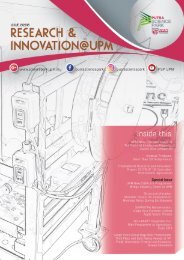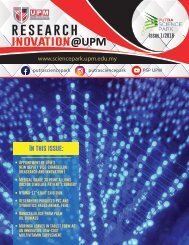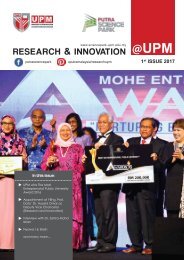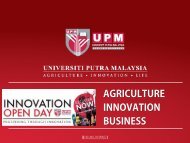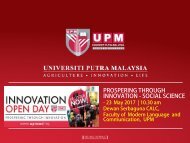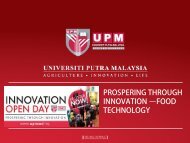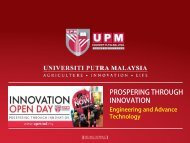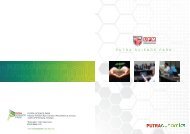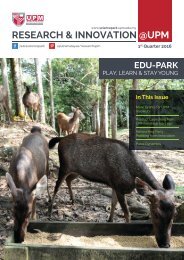Innovation directory 4th edition
You also want an ePaper? Increase the reach of your titles
YUMPU automatically turns print PDFs into web optimized ePapers that Google loves.
agriculture<br />
Eco-Friendly Fungicide for Crop Soft Rot<br />
Disease<br />
TECHNOLOGY DESCRIPTION<br />
This invention is a biological control agent using combination of<br />
Pseudomonas chlororaphis strain A4 and Bacillus subtilis strain A2.<br />
TECHNOLOGY FEATURES<br />
It specifically targets Pectobacterium spp without damaging commercial<br />
value of vegetables and fruits. It is more effective and efficient as<br />
compared to common commercial fungicides. The technology<br />
works at a wide range of pH from 1to 11 and is stable at different<br />
temperatures (30oC -75 oC). The technology has also been found to be<br />
active at different UV irradiation time. It can be utilized under different<br />
environmental circumstances. Its characteristics avoid the need for<br />
special transportation, handling, and storage of hazardous chemicals.<br />
There is no need for a high initial cost for installing special equipment to<br />
produce and dispense the product.<br />
ADVANTAGES<br />
• Eco-friendly and biodegradable<br />
• Economical to produce and apply<br />
• An alternative to hazardous chemical fungicides<br />
• Leaves no chemical residues (nontoxic, and natural)<br />
INDUSTRY OVERVIEW<br />
Prospect Industry: Fungicide Producers<br />
Assoc. Prof. Dr. Kamaruzaman Sijam<br />
Faculty of Agriculture<br />
12<br />
The global fungicides market was valued at US$11.23billion in 2014 and<br />
is likely to reach US$16.30 billion in 2023, expanding at a CAGR of 4.4%<br />
between 2015 and 2023. In terms of volume, Mancozeb accounted<br />
for the highest share of more than 20% of the global fungicide market<br />
in 2014. Mancozeb is likely to be the fastest-growing segment of the<br />
global fungicide market during the forecast period. It is yet to face any<br />
resistance management issues from various strains of fungi and is also<br />
relatively low-priced as compared to other fungicides. Strobilurins are<br />
anticipated to grow at a moderate rate however face crop resistance<br />
issues due to excessive usage. Market prospects in Malaysia include<br />
pesticides or fungicide producers and agricultural SMEs. Regions that use<br />
the largest amount of fungicide in Asia are major agricultural countries<br />
such as China, India and most ASEAN countries. Other major fungicide<br />
consumers include Brazil, Europe and the US. Europe dominated the<br />
fungicide market over the past few years on account of high production<br />
of vegetables and fruits along with wheat. In the U.S., fungicides are<br />
widely employed in the production of a large range of fruits and<br />
vegetables including apple, pecan, potato and blueberries. This is likely<br />
to propel its market over the next six years. Furthermore, governments<br />
of various countries in Asia Pacific intend to create awareness regarding<br />
appropriate usage of fungicide among farmers in order to increase crop<br />
yield and enhance quality of the produce. This is likely to boost the<br />
fungicide market in the Asia Pacific region over the projected period. The<br />
global fungicide market is consolidated; the top five players constituted<br />
more than 70% share in 2014.




